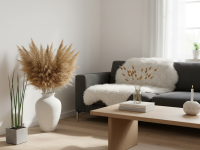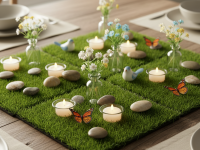Hey there, fellow furniture lover! Do you have a beautiful piece of antique oak furniture sitting in your home, perhaps passed down through generations, that’s looking a bit tired but you’re absolutely dreading the thought of stripping it down to bare wood? I totally get it. That feeling of wanting to bring back its former glory without sacrificing its soul – its original finish, its patina, its story – is a common one. And guess what? It’s absolutely achievable!
I’ve been in your shoes. I’ve stared at an old, dull oak dresser, convinced that a full strip-and-refinish was the only way. But then I discovered the gentle art of restoration, a method that respects the furniture’s history while breathing new life into it. This isn’t about transforming it into something brand new; it’s about making it look its absolute best, preserving its character, and celebrating its age. Ready to dive in? Let’s restore that cherished piece together, without touching a single chemical stripper!
Why Not Strip? Preserving the Patina and History
Before we even touch a rag, let’s talk about why avoiding the stripper is often the best choice for antique oak. That deep, rich color and subtle sheen that antique oak develops over decades, sometimes even centuries? That’s called patina. It’s the accumulated evidence of age, sunlight, touch, and successive layers of polish. It’s what gives antique furniture its unique character and tells its story.
Stripping the finish, while sometimes necessary for severely damaged pieces, essentially erases this history. It takes away the very essence that makes an antique piece valuable and charming. Our goal here is to clean, nourish, and protect the existing finish, not remove it. Think of it like a really good spa day for your furniture, rather than reconstructive surgery.
Gather Your Gentle Arsenal: Tools and Materials
You won’t need anything harsh or complicated for this process. In fact, most of these items you might already have around the house. Here’s what I usually gather before starting:
- Soft, lint-free cloths (old t-shirts work great!)
- Microfiber cloths
- Mild dish soap (e.g., Dawn)
- Warm water
- Mineral spirits (paint thier, not paint stripper!)
- Fine steel wool (#0000 or “super fine”)
- Wood furniture cleaner/restorer (like Howard Restor-A-Finish, or a good quality lemon oil/tung oil blend)
- Paste wax (e.g., clear or a suitable shade for oak)
- Small brush (an old toothbrush is perfect for crevices)
- Disposable gloves (optional, but recommended for mineral spirits)
- Small containers/bowls
- Cotton swabs
Always make sure you’re working in a well-ventilated area, especially when using mineral spirits.
The Gentle Cleanse: Removing Decades of Grime
This is where the magic truly begins. You’d be amazed at how much dirt, old wax buildup, and grime can accumulate over the years, masking the true beauty of the wood beneath. We’ll start with the least aggressive method and work our way up.
Step 1: The Initial Dust-Off
Grab a soft, dry cloth and gently wipe down the entire piece. Remove any loose dust, cobwebs, or debris. This prevents scratching the finish when you move on to liquids.
Step 2: Mild Soap and Water Wash
For general dirt and surface grime, a simple wash can work wonders. Mix a few drops of mild dish soap into a bowl of warm water. Dampen a soft cloth (make sure it’s just damp, not soaking wet) and gently wipe down a small section of the furniture. Don’t let water sit on the surface. Immediately follow up with a clean, dry cloth to thoroughly dry the area. Work in small sections, always drying immediately.
Pro Tip: Always test any cleaning solution on an inconspicuous area first, like the back of a leg or inside a drawer. You want to be sure it doesn’t harm the finish.
Step 3: Tackling Stubborn Grime and Old Wax with Mineral Spirits
If the soap and water didn’t quite cut through the gunk or if you suspect a lot of old wax buildup, mineral spirits are your best friend. Despite the name, mineral spirits are not harsh like paint stripper. They are excellent at dissolving old wax, grease, and grime without damaging most existing finishes (though, again, always test first!).
Pour a small amount of mineral spirits into a bowl. Dip a clean, soft cloth into the spirits, wring out any excess so it’s damp but not dripping. Gently wipe down a section of the furniture. You’ll likely see decades of grime lift right off onto your cloth. Change cloths frequently as they get dirty. For intricate carvings or tight spots, a cotton swab or an old toothbrush dipped in mineral spirits can be very effective. Again, work in sections and don’t let the spirits pool on the surface. Allow the area to dry completely – mineral spirits evaporate relatively quickly.
Experience Says: Don’t be alarmed if your cloth turns dark brown or black. That’s just layers of old dirt and oxidized wax coming off, revealing the true finish underneath!
Nourishing the Wood: Rejuvenating the Finish
Once your piece is thoroughly clean and dry, it’s time to feed the wood and bring back that lovely luster. This step rehydrates the finish and can miraculously diminish minor scratches and dull spots.
Step 1: Applying a Wood Restorer or Oil
Products like Howard Restor-A-Finish are fantastic for this purpose. They penetrate the existing finish to re-amalgamate it, helping to blend out minor imperfections and restore color. They come in various shades, so choose one that matches your oak (light oak, dark oak, etc.).
Alternatively, a good quality lemon oil or tung oil blend can also nourish the wood. Avoid heavy linseed oil, as it can sometimes remain sticky or attract dust over time.
Apply the chosen product liberally with a clean, soft cloth, working it into the finish following the wood grain. Let it sit for about 15-20 minutes, allowing the wood to absorb it. You might notice dull areas suddenly “waking up” with color.
Step 2: Buffing the Excess
After the absorption time, use a clean, dry cloth to vigorously wipe off any excess product. You want to remove all residue, leaving a dry-to-the-touch surface. This buffing action also helps to bring out the shine.
My Take: This step is often the most rewarding. It’s like watching a magic trick as the furniture transforms from drab to fab before your eyes!
Addressing Minor Imperfections: Scratches, Dings, and Dull Spots
Sometimes, after cleaning and nourishing, some deeper scratches or dull areas might still be visible. Remember, we’re not stripping, so we won’t be sanding these out entirely. Our goal is to minimize their appearance and blend them into the existing finish.
Surface Scratches and Scuffs: Fine Steel Wool and Restorer
For very fine surface scratches that haven’t broken through the finish, a combination of #0000 steel wool and your wood restorer can be incredibly effective. Apply the restorer to the scratch, then gently rub it in with a piece of #0000 steel wool, moving with the grain. The super fine steel wool acts as a gentle abrasive to lightly smooth the finish around the scratch, allowing the restorer to blend it better. Immediately wipe off any excess with a clean cloth.
Caution: Use this technique very sparingly and gently. Test in an inconspicuous area first. If you rub too hard, you could go through the finish.
Water Rings and Heat Marks: Gentle Abrasion (Again, with Caution!)
These can be tricky. Often, a good wood restorer or even a non-gel toothpaste rubbed gently with a cloth can lighten water rings. For more stubborn marks, some restorers suggest a very light touch with #0000 steel wool and mineral spirits or the restorer itself. The goal is to gently abrade the clouded finish layer without removing it entirely. Work slowly, in the direction of the grain, and frequently check your progress. As soon as the mark starts to fade, stop and buff thoroughly.
Dings and Minor Gouges: Wax Sticks or Touch-Up Markers
For deeper nicks or dings where the wood might be exposed, you can use furniture wax sticks or touch-up markers that match the oak’s color. Apply the wax stick or marker to fill the ding, then gently wipe away any excess with a soft cloth. This isn’t a perfect repair, but it makes the imperfection much less noticeable.
The Art of Patience: Buffing and Protecting
You’re almost there! The final steps are all about enhancing the newfound beauty and protecting it for years to come.
Step 1: The Final Polish
After letting the wood restorer or oil fully set (usually a few hours or overnight), give the entire piece a thorough buffing with a clean, dry microfiber cloth. This will bring out a beautiful, natural sheen. Keep buffing until you achieve the desired level of luster.
Step 2: Applying Paste Wax for Protection
For a durable, long-lasting protective layer and a beautiful satiny finish, apply a thin coat of good quality paste wax. Use a clean cloth to apply the wax sparingly, in a thin, even layer, following the grain. Let the wax haze for 10-15 minutes (or as per product instructions). Then, with a fresh, clean cloth (or a soft brush for carved areas), buff the wax to a deep, lustrous shine. This layer of wax will protect your newly revived finish from future dust, spills, and minor wear.
My Experience: Don’t overdo the wax! Too much will make it sticky and attract dust. A little goes a long way. You can re-wax every 6-12 months, or as needed.
Conclusion: Cherish the Character
See? You didn’t need to strip a thing! By patiently and gently cleaning, nourishing, and protecting your antique oak furniture, you’ve brought it back to life while honoring its unique history. That beautiful patina is still there, telling its story, but now it’s shining brightly for all to see. You’ve preserved its character and ensured it can continue to be a cherished piece in your home for many more years to come.
Take a step back and admire your handiwork. There’s a special satisfaction in knowing you’ve revived something old and beautiful with your own hands, respecting its past every step of the way. Enjoy your beautifully restored, naturally aged oak!
An image showing a close-up of an antique oak furniture piece (e.g., a dresser drawer or tabletop) half-cleaned and half-still with grime, illustrating the before-and-after effect of gentle cleaning without stripping. The clean side should reveal a richer, more vibrant wood grain, while the uncleaned side shows a dull, dusty, and somewhat dark appearance. Soft lighting, possibly with a gentle ray of sunlight.


